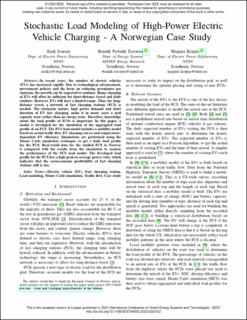| dc.contributor.author | Ivarsøy, Eirik | |
| dc.contributor.author | Torsæter, Bendik Nybakk | |
| dc.contributor.author | Korpås, Magnus | |
| dc.date.accessioned | 2020-09-29T07:53:27Z | |
| dc.date.available | 2020-09-29T07:53:27Z | |
| dc.date.created | 2020-09-24T08:52:33Z | |
| dc.date.issued | 2020 | |
| dc.identifier.isbn | 978-1-7281-4701-7 | |
| dc.identifier.uri | https://hdl.handle.net/11250/2680128 | |
| dc.description.abstract | In recent years, the number of electric vehicles (EVs) has increased rapidly. Due to technological advancement, government policies and the focus on reducing greenhouse gas emission, the growth can be expected to continue. Home charging of EVs will often be sufficient for short-distance travel and daily routines. However, EVs still have a limited range. Thus, for long-distance travel, a network of fast charging stations (FCS) is needed. The stochastic nature, high power demand and short duration of EV fast charging, make it in many cases a grid capacity issue rather than an energy issue. Therefore, knowledge about the load profile of FCSs is important. In this paper, a model is developed for the simulation of the aggregated load profile of an FCS. The FCS load model includes a mobility model based on actual traffic flow, EV charging curves and temperature-dependent EV efficiency. Simulations are performed using the Monte Carlo simulation technique, to get a daily load profile for the FCS. Real-world data for the studied FCS in Norway is compared with the results from the simulation to analyze the performance of the FCS load model. The developed load profile for the FCS has a high peak-to-average power ratio, which indicates that the socioeconomic profitability of fast charging stations still is low. | en_US |
| dc.language.iso | eng | en_US |
| dc.publisher | Institute of Electrical and Electronics Engineers (IEEE) | en_US |
| dc.relation.ispartof | 2020 International Conference on Smart Energy Systems and Technologies - SEST | |
| dc.title | Stochastic Load Modeling of High-Power Electric Vehicle Charging - A Norwegian Case Study | en_US |
| dc.type | Chapter | en_US |
| dc.description.version | acceptedVersion | en_US |
| dc.identifier.doi | 10.1109/SEST48500.2020.9203102 | |
| dc.identifier.cristin | 1832817 | |
| dc.relation.project | Norges forskningsråd: 295133 | en_US |
| dc.description.localcode | © 2020 IEEE. Personal use of this material is permitted. Permission from IEEE must be obtained for all other uses, in any current or future media, including reprinting/republishing this material for advertising or promotional purposes, creating new collective works, for resale or redistribution to servers or lists, or reuse of any copyrighted component of this work in other works. | en_US |
| cristin.ispublished | true | |
| cristin.fulltext | postprint | |
| cristin.qualitycode | 1 | |
